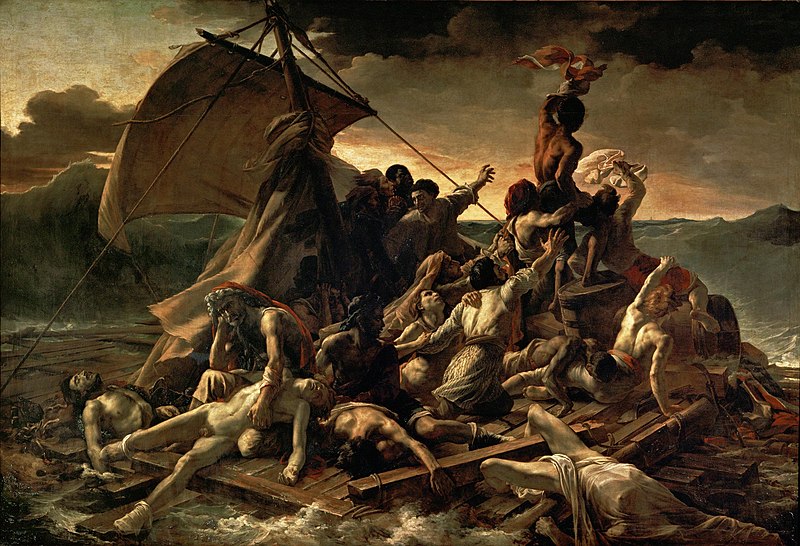
The Raft of the Medusa, Géricault, 1818-1819, Oil on canvas, Louvre, Paris
“The Raft of the Medusa,” painted by Théodore Géricault in 1818-1819, is a monumental work that stands as a seminal example of history painting in France during the 19th century. Géricault’s masterpiece captures a tragic episode from French naval history, the wreck of the frigate Medusa, and epitomizes the Romantic movement’s emphasis on emotional intensity and social commentary.
Historical Context: The painting depicts the aftermath of the wreck of the Medusa off the coast of Senegal in 1816, where survivors were left adrift on a makeshift raft. Géricault, influenced by a sensationalized firsthand account, chose to portray the human suffering, desperation, and survival instincts of those stranded at sea for thirteen days.
Romanticism and Emotional Impact: As a history painting, “The Raft of the Medusa” aligns with the Romantic movement’s rejection of classical ideals and emphasis on emotion and individual experience. Géricault’s composition is monumental and dramatic, capturing the raw intensity of the human struggle for survival. The painting’s scale and emotional power serve as a testament to the Romantic belief in art’s ability to evoke strong emotions and societal reflection.
Political and Social Commentary: Beyond its dramatic depiction of a maritime disaster, Géricault’s painting also carries a socio-political message. The Medusa incident was marred by incompetence and political corruption, and Géricault used his art to critique these failings. The painting serves as a powerful indictment of the French government’s negligence and highlights broader themes of human suffering and resilience in the face of systemic failures.
Composition and Realism: Géricault’s attention to detail and commitment to realism contribute to the impact of the painting. The carefully rendered expressions, the depiction of the human form, and the stark contrasts of light and shadow all enhance the sense of immediacy and authenticity. The composition, with its pyramidal structure and central focus on a figure waving for rescue, draws the viewer into the heart-wrenching narrative.
Legacy and Influence: “The Raft of the Medusa” has left an enduring mark on the history of art. It exemplifies the shift towards realism and social commentary in history painting and has influenced subsequent generations of artists. Géricault’s bold departure from traditional representations of historical events paved the way for a more nuanced and critical approach to storytelling through visual art.
In conclusion, Géricault’s “The Raft of the Medusa” not only encapsulates the tragic events of the Medusa shipwreck but also exemplifies the evolution of history painting in France during the 19th century. Its emotional power, political undertones, and commitment to realism make it a landmark work that continues to resonate with audiences today.
